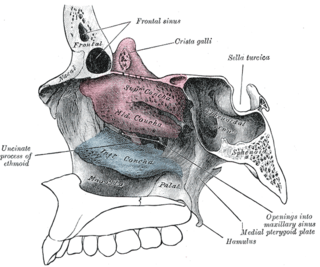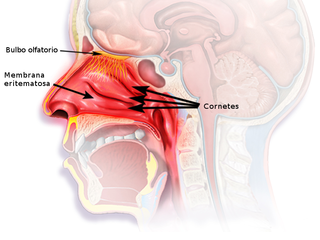Related Research Articles

The olfactory nerve, also known as the first cranial nerve, cranial nerve I, or simply CN I, is a cranial nerve that contains sensory nerve fibers relating to the sense of smell.
Articles related to anatomy include:

The vomeronasal organ (VNO), or Jacobson's organ, is the paired auxiliary olfactory (smell) sense organ located in the soft tissue of the nasal septum, in the nasal cavity just above the roof of the mouth in various tetrapods. The name is derived from the fact that it lies adjacent to the unpaired vomer bone in the nasal septum. It is present and functional in all snakes and lizards, and in many mammals, including cats, dogs, cattle, pigs, and some primates. Some humans may have physical remnants of a VNO, but it is vestigial and non-functional.

The nasal cavity is a large, air-filled space above and behind the nose in the middle of the face. The nasal septum divides the cavity into two cavities, also known as fossae. Each cavity is the continuation of one of the two nostrils. The nasal cavity is the uppermost part of the respiratory system and provides the nasal passage for inhaled air from the nostrils to the nasopharynx and rest of the respiratory tract.

The olfactory bulb is a neural structure of the vertebrate forebrain involved in olfaction, the sense of smell. It sends olfactory information to be further processed in the amygdala, the orbitofrontal cortex (OFC) and the hippocampus where it plays a role in emotion, memory and learning. The bulb is divided into two distinct structures: the main olfactory bulb and the accessory olfactory bulb. The main olfactory bulb connects to the amygdala via the piriform cortex of the primary olfactory cortex and directly projects from the main olfactory bulb to specific amygdala areas. The accessory olfactory bulb resides on the dorsal-posterior region of the main olfactory bulb and forms a parallel pathway. Destruction of the olfactory bulb results in ipsilateral anosmia, while irritative lesions of the uncus can result in olfactory and gustatory hallucinations.

In anatomy, a nasal concha, also called a nasal turbinate or turbinal, is a long, narrow, curled shelf of bone that protrudes into the breathing passage of the nose in humans and various animals. The conchae are shaped like an elongated seashell, which gave them their name. A concha is any of the scrolled spongy bones of the nasal passages in vertebrates.

In physiology, a stimulus is a detectable change in the physical or chemical structure of an organism's internal or external environment. The ability of an organism or organ to detect external stimuli, so that an appropriate reaction can be made, is called sensitivity (excitability). Sensory receptors can receive information from outside the body, as in touch receptors found in the skin or light receptors in the eye, as well as from inside the body, as in chemoreceptors and mechanoreceptors. When a stimulus is detected by a sensory receptor, it can elicit a reflex via stimulus transduction. An internal stimulus is often the first component of a homeostatic control system. External stimuli are capable of producing systemic responses throughout the body, as in the fight-or-flight response. In order for a stimulus to be detected with high probability, its level of strength must exceed the absolute threshold; if a signal does reach threshold, the information is transmitted to the central nervous system (CNS), where it is integrated and a decision on how to react is made. Although stimuli commonly cause the body to respond, it is the CNS that finally determines whether a signal causes a reaction or not.

An olfactory receptor neuron (ORN), also called an olfactory sensory neuron (OSN), is a sensory neuron within the olfactory system.

The olfactory epithelium is a specialized epithelial tissue inside the nasal cavity that is involved in smell. In humans, it measures 5 cm2 (0.78 sq in) and lies on the roof of the nasal cavity about 7 cm (2.8 in) above and behind the nostrils. The olfactory epithelium is the part of the olfactory system directly responsible for detecting odors.

The glomerulus is a spherical structure located in the olfactory bulb of the brain where synapses form between the terminals of the olfactory nerve and the dendrites of mitral, periglomerular and tufted cells. Each glomerulus is surrounded by a heterogeneous population of juxtaglomerular neurons and glial cells.

A sustentacular cell is a type of cell primarily associated with structural support, they can be found in various tissues.
In medicine and anatomy, the special senses are the senses that have specialized organs devoted to them:

Olfactory glands, also known as Bowman's glands, are a type of nasal gland situated in the part of the olfactory mucosa beneath the olfactory epithelium, that is the lamina propria, a connective tissue also containing fibroblasts, blood vessels and bundles of fine axons from the olfactory neurons.

The human nose is the most protruding part of the face. It bears the nostrils and is the first organ of the respiratory system. It is also the principal organ in the olfactory system. The shape of the nose is determined by the nasal bones and the nasal cartilages, including the nasal septum which separates the nostrils and divides the nasal cavity into two. On average, the nose of a male is larger than that of a female.
Dysosmia is a disorder described as any qualitative alteration or distortion of the perception of smell. Qualitative alterations differ from quantitative alterations, which include anosmia and hyposmia. Dysosmia can be classified as either parosmia or phantosmia. Parosmia is a distortion in the perception of an odorant. Odorants smell different from what one remembers. Phantosmia is the perception of an odor when no odorant is present. The cause of dysosmia still remains a theory. It is typically considered a neurological disorder and clinical associations with the disorder have been made. Most cases are described as idiopathic and the main antecedents related to parosmia are URTIs, head trauma, and nasal and paranasal sinus disease. Dysosmia tends to go away on its own but there are options for treatment for patients that want immediate relief.

Cannabinoid receptor 1 (CB1), is a G protein-coupled cannabinoid receptor that in humans is encoded by the CNR1 gene. The human CB1 receptor is expressed in the peripheral nervous system and central nervous system. It is activated by: endocannabinoids, a group of retrograde neurotransmitters that include anandamide and 2-arachidonoylglycerol (2-AG); plant phytocannabinoids, such as docosatetraenoylethanolamide found in wild daga, the compound THC which is an active constituent of the psychoactive drug cannabis; and, synthetic analogs of THC. CB1 is antagonized by the phytocannabinoid tetrahydrocannabivarin (THCV).

The sense of smell, or olfaction, is the special sense through which smells are perceived. The sense of smell has many functions, including detecting desirable foods, hazards, and pheromones, and plays a role in taste.

The nasal mucosa lines the nasal cavity. It is part of the respiratory mucosa, the mucous membrane lining the respiratory tract. The nasal mucosa is intimately adherent to the periosteum or perichondrium of the nasal conchae. It is continuous with the skin through the nostrils, and with the mucous membrane of the nasal part of the pharynx through the choanae. From the nasal cavity its continuity with the conjunctiva may be traced, through the nasolacrimal and lacrimal ducts; and with the frontal, ethmoidal, sphenoidal, and maxillary sinuses, through the several openings in the nasal meatuses. The mucous membrane is thickest, and most vascular, over the nasal conchae. It is also thick over the nasal septum where increased numbers of goblet cells produce a greater amount of nasal mucus. It is very thin in the meatuses on the floor of the nasal cavities, and in the various sinuses. It is one of the most commonly infected tissues in adults and children. Inflammation of this tissue may cause significant impairment of daily activities, with symptoms such as stuffy nose, headache, mouth breathing, etc.

Vomeronasal receptors are a class of olfactory receptors that putatively function as receptors for pheromones. Pheromones have evolved in all animal phyla, to signal sex and dominance status, and are responsible for stereotypical social and sexual behaviour among members of the same species. In mammals, these chemical signals are believed to be detected primarily by the vomeronasal organ (VNO), a chemosensory organ located at the base of the nasal septum.
Odor molecules are detected by the olfactory receptors in the olfactory epithelium of the nasal cavity. Each receptor type is expressed within a subset of neurons, from which they directly connect to the olfactory bulb in the brain. Olfaction is essential for survival in most vertebrates; however, the degree to which an animal depends on smell is highly varied. Great variation exists in the number of OR genes among vertebrate species, as shown through bioinformatic analyses. This diversity exists by virtue of the wide-ranging environments that they inhabit. For instance, dolphins that are secondarily adapted to an aquatic niche possess a considerably smaller subset of genes than most mammals. OR gene repertoires have also evolved in relation to other senses, as higher primates with well-developed vision systems tend to have a smaller number of OR genes. As such, investigating the evolutionary changes of OR genes can provide useful information on how genomes respond to environmental changes. Differences in smell sensitivity are also dependent on the anatomy of the olfactory apparatus, such as the size of the olfactory bulb and epithelium.
References
- 1 2 3 4 Sinnatamby, Chummy S. (2011). Last's Anatomy (12th ed.). Elsevier Australia. p. 373. ISBN 978-0-7295-3752-0.
- 1 2 "pars olfactoria tunicae mucosae nasi". TheFreeDictionary.com. Retrieved 2023-06-12.
- ↑ "fila olfactoria". TheFreeDictionary.com. Retrieved 2023-06-12.
- ↑ "pars respiratoria tunicae mucosae". TheFreeDictionary.com. Retrieved 2023-06-12.
- 1 2 Standring, Susan (2020). Gray's Anatomy: The Anatomical Basis of Clinical Practice (42th ed.). New York. p. 692. ISBN 978-0-7020-7707-4. OCLC 1201341621.
{{cite book}}: CS1 maint: location missing publisher (link) - ↑ Moran, David T.; Rowley Jc, 3rd; Jafek, BW; Lovell, MA (1982), "The fine structure of the olfactory mucosa in man", Journal of Neurocytology, 11 (5): 721–746, doi:10.1007/BF01153516, PMID 7143026, S2CID 25263022
- ↑ Schwob, James E. (2002), "Neural Regeneration and the Peripheral Olfactory System", The Anatomical Record, 269 (1): 33–49, doi: 10.1002/ar.10047 , PMID 11891623
- 1 2 Frisch, Donald (1967), "Ultrastructure of mouse olfactory mucosa.", The American Journal of Anatomy, 121 (1): 87–120, doi:10.1002/aja.1001210107, PMID 6052394
- ↑ Gartner, Leslie P.; Hiatt, James L. (2007). Color Textbook of Histology. Saunders/Elsevier. p. 349. ISBN 978-1-4160-2945-8.
- ↑ Tegoni, Mariella; Pelosi, P; Vincent, F; Spinelli, S; Campanacci, V; Grolli, S; Ramoni, R; Cambillau, C (2000), "Mammalian odorant binding proteins", Biochimica et Biophysica Acta (BBA) - Protein Structure and Molecular Enzymology (published 1967), 1482 (1–2): 229–240, doi:10.1016/S0167-4838(00)00167-9, PMID 11058764
- ↑ Eskitis Institute for Cell and Molecular Therapies
- ↑ Palouzier-Paulignan, Brigitte; Lacroix, Marie-Christine; Aimé, Pascaline; Baly, Christine; Caillol, Monique; Congar, Patrice; Julliard, A. Karyn; Tucker, Kristal; Fadool, Debra Ann (2012-11-01). "Olfaction Under Metabolic Influences". Chemical Senses. 37 (9): 769–797. doi:10.1093/chemse/bjs059. ISSN 0379-864X. PMC 3529618 . PMID 22832483.